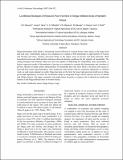| dc.contributor.author | Manyong, Victor M | |
| dc.contributor.author | Alene, Arega D | |
| dc.contributor.author | Odhiambo, George D | |
| dc.contributor.author | Mignouna, H.D | |
| dc.contributor.author | Bokanga, M | |
| dc.contributor.author | Omanya, G | |
| dc.contributor.author | Nindi, S.J | |
| dc.date.accessioned | 2018-06-12T09:52:02Z | |
| dc.date.available | 2018-06-12T09:52:02Z | |
| dc.date.issued | 2008-11 | |
| dc.identifier.uri | https://repository.maseno.ac.ke/handle/123456789/565 | |
| dc.description.abstract | Striga hermonthica (del) Benth is threatening rural livelihoods in western Kenya where maize is the major food
and cash crop. Vulnerability analysis was conducted on a sample of 802 households in eight districts of Nyanza
and Western provinces. Farmers perceived Striga as the major cause of poverty and food insecurity. Both
household income and child nutrition indicators showed alarming conditions for the majority of households. The
coping strategies and informal safety nets were not capable of addressing the vulnerability issue successfully. A
logistic regression model of determinants of poverty was estimated to examine the determinants and correlates of
poverty. Results revealed certain characteristics of households that were more likely to be poor: poor access to
land and farm assets; high dependency ratio; headed by older farmer with low education attainment; no off-farm
work, no cash crops; depend on credit; Striga has been on the farm for long, high perceived yield loss to Striga
given high dependency on maize for livelihoods; adopt no integrated Striga control options; and live in Bondo
and Vihiga districts. The paper concludes with implications for policy to improve the livelihoods of small-scale
farmers in the Striga-affected areas of western Kenya. | en_US |
| dc.subject | livelihoods, maize, Striga, Kenya, Logit | en_US |
| dc.title | Livelihood strategies of resource-poor farmers in Striga-infested areas of western Kenya | en_US |
| dc.type | Article | en_US |

